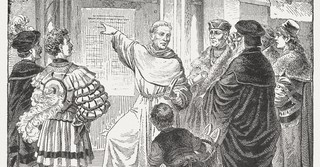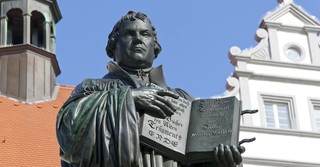5 Things You’re Probably Misunderstanding about the 95 Theses
Share

When I was in high school, I learned about a man named Martin Luther. I was taught he was a powerful figure and led the team for the Protestant Reformation. He alone posted his 95 Theses to the door of Wittenberg Castle, and he alone led the charge to take down the Catholic Church.
Well, I was wrong.
Martin Luther is an important figure in the Protestant Reformation and his 95 Theses are a critical document which shows Christians what it means to question authority and theology. Let’s take a step back in history and discover the man who wrote the 95 Theses and extract what we need to know about them.
Photo credit: ©Getty Images/ZU_09
Who Was Martin Luther?

Martin Luther was not always a man of the cloth. He was born in Eisleben, Saxony, which is now Germany, in 1483. This area was part of the Holy Roman Empire. As a young boy, Luther began his education at a local school. He learned Latin, reading, and writing. When Luther was 13, he started attending a school in Magdeburg run by the Brethren of the Common Life. The Brethren school focused on personal piety and Luther felt the spark to explore monastic life.
Luther’s father wanted him to become a lawyer, but Martin had other plans for his life. In 1501, Martin Luther enrolled in the University of Erfurt. This was the premier university in Germany. While there he studied the usual subjects and was granted a Master’s degree in 1505. After an encounter with a storm and bolt of lightning, Martin Luther entered an Augustinian monastery.
During his time in the monastery, Luther continued to study at the University of Erfurt. He received a doctorate degree in 1512 and became a professor of biblical studies. He also served as a representative in Rome for the German Augustinian monasteries from 1510-1511.
Luther never stopped studying. He had a thirst for knowledge that eventually led him to question the activities of the Roman Catholic Church. His questions were revealed in what we know as the 95 Theses, or as Luther titled them, Disputation of Power and Efficacy of Indulgences.
5 Things We Should Know About the 95 Theses
Martin Luther didn’t know he had created a document that would change the face of Christianity and ultimately lead to what we know as the Protestant Reformation.
Photo credit: ©Getty Images/typo-graphics
1. A Scandal and Humanist Thought Led the Way to the 95 Theses

To truly understand Martin Luther’s motivation for writing his theses, we must know where it all began.
St. Peter’s Basilica was a structure meant to inspire the people. It was to be a sermon in stone. Emperor Constantine would make it possible for Christians to come out from hiding when he arrived in Rome and made the decision to build a shrine over what is thought to be the grave of Saint Peter. Over the centuries, St. Peter’s would degrade and be repaired by popes.
When Pope Nicholas V made his permanent home in Rome, he began the task of building a new and greater Basilica. Pope Nicholas V was a proponent of the humanist movement and felt the church needed to move and change with the times. Building a grand structure was how he planned to show Christians how to reconcile humanism and Christianity.
But building St. Peter’s Basilica would cost money. Money was at a shortage in the Vatican Treasury. To finance the construction of the Basilica, Pope Julius II turned to the sale of indulgences. People were making their pilgrimage to Rome to confess their sins and ask forgiveness. The priest would grant them forgiveness and their punishment would be to place a determined amount of money into the treasury.
At first the money was flowing like honey, but all this would backfire when people began to question the sale of indulgences.
2. The Formation of the Protestant Church Was Not the Outcome Martin Luther Desired
Before Martin Luther wrote his 95 Theses, he was a devout and learned monk. He loved God and felt secure in the ministry he was living out. He was not an enemy of the Catholic Church, rather a devout supporter. He truly wanted people to know the love of God. Never would he have imagined what the outcome of his theses would be.
Martin Luther wrote his theses with one purpose in mind. He wanted to encourage a healthy debate of the issues plaguing the church. He wanted those in authority to take a close look at what was happening and decide how their actions reflected the love of God. He was not challenging authority. His 95 Theses were not accusing, rather they were questioning.
Luther does not mention Protestant distinctives such as justification by faith alone. All 95 deal with purgatory, selling of indulgences, and the pope’s role in the two, which are distinctly Catholic teachings.
Photo credit: ©Getty Images/Tinnakorn Jorruang
3. The 95 Theses Weren’t Meant to Travel the Globe

When Martin Luther was writing his disputation, he could not have imagined the effect they would have on the Catholic church, let alone how they would change the face of religion. The story goes that he nailed them to a church door and with each swing of his hammer, all of Europe were alarmed. Most likely he glued the theses to the church door at Wittenberg, but we don’t know.
What we do know is that Luther was wanting to discuss the issues of the day and placing the theses on the church door meant others would see it and prepare their own thoughts. Due to the invention of the printing press, Luther’s theses were copied and sent all over Europe. All of the known world would know what was happening in the Catholic Church and how one man felt about it.
4. The First Two Theses Are the Inspiration for The Other 93.
All 95 theses are important but the first two are what sets the tone for the other 93. In theses number Luther says,
1. “When our Lord and Master Jesus Christ, in saying, ‘Repent ye,’ etc. intended that the whole life of believers should be penitence."
2. “This word cannot be understood of sacramental penance, that is, of the confession and satisfaction which are performed under the ministry of priests.”
In both of these theses, Luther is speaking about the truth which is that salvation is only obtained through faith. They both show that God desires all believers to seek him and repent. The rest of Luther’s theses are concerned with indulgences and how they do not line up with theses one and two. He even touches on the St. Peter scandal in theses 86.
“Again, ‘Why does not the pope, whose wealth is today greater than the wealth of the richest Crassus, build this one basilica of St. Peter with his own money rather than the money of poor believers.”
Luther wanted the people to understand that selling indulgences was not what Christ spoke about in Scripture. God wanted his people to have salvation by faith and live a life that exemplified who He was. He wanted the people to know that only God can give forgiveness, not man. No amount of money would save them from their wicked ways.
Photo credit: Unsplash/Juliana Kozoski
5. All 95 Theses Were Not Against Catholic Teachings

Martin Luther’s 95 Theses sparked the Protestant Reformation and led to the creation of a Lutheran denomination. Even so, we should know that all 95 theses were not against the Catholic Church. The first three are parallels of teachings found in the Catechism of the Catholic Church.
For example:
Thesis 3: “Yet it (the call to repent) does not mean solely inner repentance; such inner repentance is worthless unless it produces various outward mortification of the flesh.”
The Catechism of the Catholic Church 1430: Jesus’s call to conversion and penance, like that of the prophets before him, does not aim first at outward works, like “sackcloth and ashes,” fasting and mortification, but at the conversion of the heart, interior conversion. Without this, such penances remain sterile and false; however, interior conversion urges expression in visible signs, gestures, and works of penance.
This is evidence that Martin Luther was devout to his church. He just wanted them to recognize what was going on and be sure they were about the work of God, not man.
Conclusion
The last words of Martin Luther’s 95 Theses say,
“But on my part, as I have often done before, so now too, I implore all men, by the faith of Christ, either to point out to me a better way, if such a way has been divinely revealed to any, or at least to submit their opinion to the judgment of God and of the Church. For I am neither so rash as to wish that my sole opinion should be preferred to that of all other men, nor so senseless as to be willing that the word of God should be made to give place to fables, devised by human reason.”
These words tell us what we need to know about the 95 Theses and Martin Luther. He may have changed the face of Christianity, but he didn’t desire that. All he desired was that the Gospel be spread throughout the nations and people come to the true saving grace of Jesus Christ.
References
The Role of Indulgences in the Building of New Saint Peter’s Basilica – Justice, Ginny, “The Role of Indulgences in the Building of Saint Peter’s Basilica” (2011). Masters of Liberal Studies Theses.7.
10 Things to Know About Martin Luther and His 95 Theses
9.5 Myths About The Reformation by Peter Marshall
Martin Luther and the 95 Theses
Photo credit: ©Getty Images/Photoboyko
